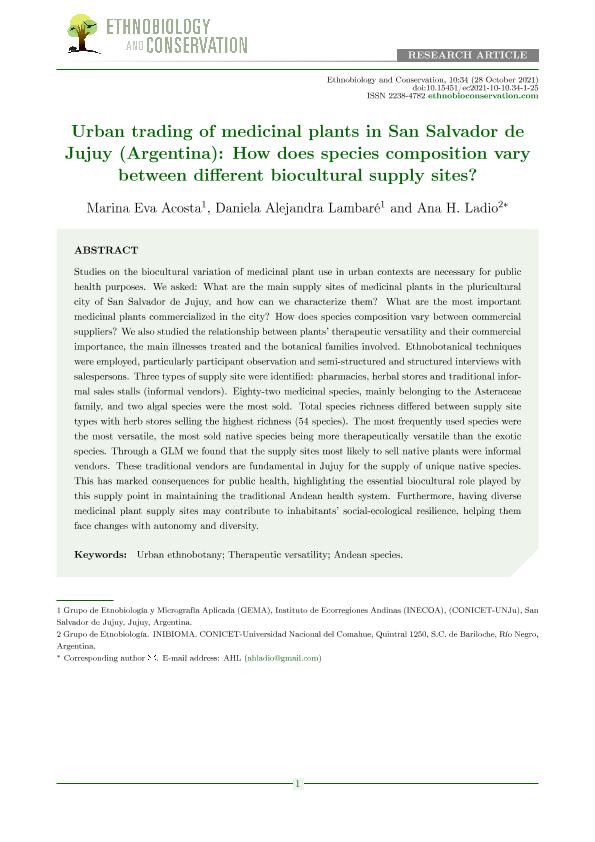Mostrar el registro sencillo del ítem
dc.contributor.author
Acosta, Marina Eva

dc.contributor.author
Lambaré, Daniela Alejandra

dc.contributor.author
Ladio, Ana Haydee

dc.date.available
2022-05-07T02:22:51Z
dc.date.issued
2021-10
dc.identifier.citation
Acosta, Marina Eva; Lambaré, Daniela Alejandra; Ladio, Ana Haydee; Urban trading of medicinal plants in San Salvador de Jujuy (Argentina): How does species composition vary between different biocultural supply sites?; Universidade Federal Pernambuco ; Universida de Estadual da Paraíba; Ethnobiology and Conservation; 10; 34; 10-2021; 1-25
dc.identifier.issn
2238-4782
dc.identifier.uri
http://hdl.handle.net/11336/156865
dc.description.abstract
Studies on the biocultural variation of medicinal plant use in urban contexts are necessary for public health purposes. We asked: What are the main supply sites of medicinal plants in the pluricultural city of San Salvador de Jujuy, and how can we characterize them? What are the most important medicinal plants commercialized in the city? How does species composition vary between commercial suppliers? We also studied the relationship between plants’ therapeutic versatility and their commercial importance, the main illnesses treated and the botanical families involved. Ethnobotanical techniques were employed, particularly participant observation and semi-structured and structured interviews with salespersons. Three types of supply site were identified: pharmacies, herbal stores and traditional informal sales stalls (informal vendors). Eighty-two medicinal species, mainly belonging to the Asteraceae family, and two algal species were the most sold. Total species richness differed between supply site types with herb stores selling the highest richness (54 species). The most frequently used species were the most versatile, the most sold native species being more therapeutically versatile than the exotic species. Through a GLM we found that the supply sites most likely to sell native plants were informal vendors. These traditional vendors are fundamental in Jujuy for the supply of unique native species. This has marked consequences for public health, highlighting the essential biocultural role played by this supply point in maintaining the traditional Andean health system. Furthermore, having diverse medicinal plant supply sites may contribute to inhabitants’ social-ecological resilience, helping them face changes with autonomy and diversity.
dc.format
application/pdf
dc.language.iso
eng
dc.publisher
Universidade Federal Pernambuco ; Universida de Estadual da Paraíba
dc.rights
info:eu-repo/semantics/openAccess
dc.rights.uri
https://creativecommons.org/licenses/by-nc-sa/2.5/ar/
dc.subject
URBAN ETHNOBOTANY
dc.subject
THERAPEUTIC VERSATILITY
dc.subject
ANDEAN SPECIES
dc.subject.classification
Conservación de la Biodiversidad

dc.subject.classification
Ciencias Biológicas

dc.subject.classification
CIENCIAS NATURALES Y EXACTAS

dc.title
Urban trading of medicinal plants in San Salvador de Jujuy (Argentina): How does species composition vary between different biocultural supply sites?
dc.type
info:eu-repo/semantics/article
dc.type
info:ar-repo/semantics/artículo
dc.type
info:eu-repo/semantics/publishedVersion
dc.date.updated
2022-01-27T18:15:55Z
dc.journal.volume
10
dc.journal.number
34
dc.journal.pagination
1-25
dc.journal.pais
Brasil

dc.journal.ciudad
Paraíba
dc.description.fil
Fil: Acosta, Marina Eva. Universidad Nacional de Jujuy. Instituto de Ecorregiones Andinas. Consejo Nacional de Investigaciones Científicas y Técnicas. Centro Científico Tecnológico Conicet - Salta. Instituto de Ecorregiones Andinas; Argentina
dc.description.fil
Fil: Lambaré, Daniela Alejandra. Universidad Nacional de Jujuy. Instituto de Ecorregiones Andinas. Consejo Nacional de Investigaciones Científicas y Técnicas. Centro Científico Tecnológico Conicet - Salta. Instituto de Ecorregiones Andinas; Argentina
dc.description.fil
Fil: Ladio, Ana Haydee. Universidad Nacional del Comahue. Centro Regional Universitario Bariloche. Laboratorio de Ecotono; Argentina. Consejo Nacional de Investigaciones Científicas y Técnicas. Centro Científico Tecnológico Conicet - Patagonia Norte. Instituto de Investigaciones en Biodiversidad y Medioambiente. Universidad Nacional del Comahue. Centro Regional Universidad Bariloche. Instituto de Investigaciones en Biodiversidad y Medioambiente; Argentina
dc.journal.title
Ethnobiology and Conservation
dc.relation.alternativeid
info:eu-repo/semantics/altIdentifier/doi/http://dx.doi.org/10.15451/ec2021-10-10.34-1-25
dc.relation.alternativeid
info:eu-repo/semantics/altIdentifier/url/https://www.ethnobioconservation.com/index.php/ebc/article/view/554/331
Archivos asociados
